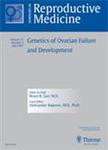版权所有:内蒙古大学图书馆 技术提供:维普资讯• 智图
内蒙古自治区呼和浩特市赛罕区大学西街235号 邮编: 010021

作者机构:Univ Laval Med Ctr Oncol & Mol Endocrinol Res Ctr Canc Genom LabCHULRes Ctr Quebec City PQ G1V 4G2 Canada Univ Lyon INSERM Lab Biochim Endocrinienne U 329 Lyon France Hop Debrousse Lyon France
出 版 物:《SEMINARS IN REPRODUCTIVE MEDICINE》 (生殖医学文集)
年 卷 期:2002年第20卷第3期
页 面:255-276页
核心收录:
学科分类:0710[理学-生物学] 1002[医学-临床医学] 100211[医学-妇产科学] 10[医学]
基 金:National Institute on Aging(R01AG053582)
主 题:congenital adrenal hyperplasia male pseudohermaphroditism adrenal ovary testis structure-function relationships molecular diagnosis steroidogenesis
摘 要:The 3beta-hydroxysteroid dehydrogenase/Delta(5)-Delta(4) isomerase (3beta-HSD) isoenzymes are responsible for the oxidation and isomerization of Delta(5)-3beta-hydroxysteroid precursors into Delta(4)-ketosteroids, thus catalyzing an essential step in the formation of all classes of active steroid hormones. The 3beta-HSD gene family should have evolved to facilitate differential patterns of tissue- and cell-specific expression and regulation involving multiple signal transduction pathways, which are activated by several growth factors, steroids, and cytokines. In humans, there are two 3beta-HSD isoenzymes, which were chronologically designated type I and II encoded by HSD3B1 and HSD3B2 gene, respectively. HSD3B1 gene encodes the almost exclusive 3beta-HSD isoenzyme expressed in the placenta and peripheral tissues, whereas HSD3B2 gene encodes the predominant 3P-HSD isoenzyme expressed in the adrenal gland, ovary, and testis and its deficiency is responsible for a rare form of congenital adrenal hyperplasia causing various degrees of salt-wasting in both sexes and incomplete masculinization of the external genitalia in genetic males. Although an elevated ratio of Delta(5)-/Delta(4) -steroids was considered to be the best biological parameter for the diagnosis of this autosomal recessive disorder, the most accurate criteria now appears to be the plasma levels of 17-OH-pregnenolone greater than 100 nmol/L following ACTH stimulation. To date a total of 34 mutations (including 5 frameshift, 4 nonsense, 1 in-frame deletion, 1 splicing, and 23 missense mutations) have been identified in the HSD3B2 gene in 56 individuals from 44 families suffering from classical 3beta-HSD deficiency. In almost all the cases, the functional characterization of HSD3B2 mutations has provided a molecular explanation for the heterogeneous clinical presentation of this disorder. Indeed these experiments confirm that no functional 3betaHSD type II isoenzyme is expressed in the adrenals and gonads of